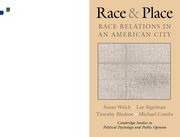Book contents
- Frontmatter
- Contents
- List of Figures
- List of Tables
- Preface
- 1 Introduction
- 2 Race Relations in Detroit, 1968–1992
- 3 Black–White Social Interaction
- 4 Perceptions of Racial Discrimination
- 5 Black Racial Solidarity
- 6 White Racial Prejudice
- 7 Opinions on Urban Issues: The Schools and the Police
- 8 Conclusions
- Appendix A The Detroit Surveys
- Appendix B Detroit Survey Items and Measures
- References
- Author Index
- Subject Index
- Miscellaneous Endmatter
4 - Perceptions of Racial Discrimination
Published online by Cambridge University Press: 05 June 2012
- Frontmatter
- Contents
- List of Figures
- List of Tables
- Preface
- 1 Introduction
- 2 Race Relations in Detroit, 1968–1992
- 3 Black–White Social Interaction
- 4 Perceptions of Racial Discrimination
- 5 Black Racial Solidarity
- 6 White Racial Prejudice
- 7 Opinions on Urban Issues: The Schools and the Police
- 8 Conclusions
- Appendix A The Detroit Surveys
- Appendix B Detroit Survey Items and Measures
- References
- Author Index
- Subject Index
- Miscellaneous Endmatter
Summary
“If I outrank a person and he gets a job because of his color, then there's something wrong” (Holmes, 2000). This complaint by a white sergeant in the U.S. Army about his black counterpart who got the promotion that both desired could even more likely have been spoken by African Americans throughout the military or in civilian life. However, it is also the voice of many whites who believe they have been passed over for jobs, promotions, or admission to elite universities because of perceived preferences given to African Americans. In twenty-first century America, race relations are rife with such resentment – resentment by blacks of both historical and contemporary antiblack discrimination and resentment by whites of attempts to remedy that history of discrimination through affirmative action.
Perceptions of racial discrimination lie near, if not at, the center of America's troubled race relations. These perceptions play a key role in people's views of the world around them, the community in which they live, and the potential remedies they favor for social, economic, and political problems (Sigelman and Welch, 1991). Building bridges between people of different races will depend, at least in part, on whether the realities of day-to-day racial contact can undermine a belief that others are getting special treatment based on their race. In this chapter, our focus is on perceptions of discrimination and how the neighborhood context helps shape them.
- Type
- Chapter
- Information
- Race and PlaceRace Relations in an American City, pp. 71 - 93Publisher: Cambridge University PressPrint publication year: 2001
- 1
- Cited by

